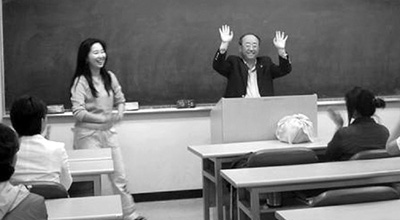
Night school was first introduced in 1906 as a part of an edification movement in rural areas with the purpose of educating women, girls and farmers who could not receive a formal education. The number of schools increased during the period of Japanese rule, as many existing schools were being abolished due to pressures asserted by the Japanese government.
After independence, many night schools participated in social movements to fight for the rights of the neglected. These days, night schools not only teach students to prepare for qualification examinations, but also provide them with art and computer lessons, and aim to become a community base for human relationships. Currently, there are about 500 night schools in Korea.
Chae Min-ji (Political Science & Diplomacy, 3), inspired by her mother who studied for her own college entrance exam while Chae was in high school, has volunteered for two years at Saint Ignatius Night School. Chae regretted not having helped her mother at that time and was looking for something productive to do to enlighten her somewhat tedious school life. So, she knocked on the door of Saint Ignatius Night School located inside Sogang University.
Chae goes to school twice a week, once for teaching and the other for administrative duties. On the day of night duty, she is responsible for preparing dinner for the students and teachers.
Classes are from 7:00 to 10:00 p.m., Monday to Friday. The one year course begins each September. Students have a field day in April and go on a school excursion in August, just like ordinary schools. "We also hold an entrance and a graduation ceremony for students. Our purpose is to make our school as similar to formal schools as possible," says Chae. Students are mostly women in their 50s and 60s with a checkered career and have a story that seems like a script of a movie.
Here at Saint Ignatius Night School, teachers are in charge of everything from teaching to planning and managing the school. Through regular meetings and studies they try to find the best method and programs for teaching the students. Thus, teachers are always open to make new attempts in teaching and even if it comes to a failure, they can be forgiven because they are not professionals.
Chae explains that volunteering at night school is different from other volunteer work. "I wouldn't say it is a volunteer activity. Rather it is more like being a real teacher at a school. Students shouldn't come here regarding it as another chance to accumulate experiences." Volunteering to work as a teacher definitely requires a lot of input of his/her time and effort. It can be a burden, especially for students who also have to take care of school work. "After all, it is a battle with your responsibility," said Chae.
Despite these burdens, Chae continues to serve the students at Saint Ignatius Night School because she is also learning from the students, who attend her class even in the pouring rain.
Saint Ignatius Night School is recruiting students who are interested in teaching. Those who are ready to invest his/her time to do the most valuable thing in life, which is to teach others, are welcomed.
Ewha Voice
evoice@ewha.ac.kr

